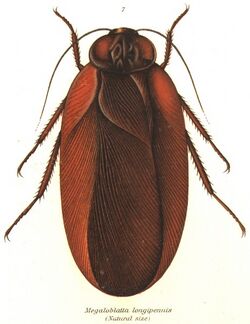Biology:Megaloblatta
| Megaloblatta | |
|---|---|

| |
| Megaloblatta longipennis | |
| Scientific classification | |
| Domain: | Eukaryota |
| Kingdom: | Animalia |
| Phylum: | Arthropoda |
| Class: | Insecta |
| Order: | Blattodea |
| Family: | Ectobiidae |
| Subfamily: | Nyctiborinae |
| Genus: | Megaloblatta Dohrn, 1887 |
| Species | |
| |
Megaloblatta is a genus of Neotropical cockroaches in the family Ectobiidae. Species in this genus are 4 to 9.7 cm (1.6–3.8 in) long and can have a wingspan of up to 20 cm (8 in); the world's largest cockroach by length and wingspan is M. longipennis.[1][2][3]
Megaloblatta, like many other insects, use stridulation in order to steer their predators away.[4] The stridulating insects are less likely to be preyed upon in comparison to individuals of the species with an inability to stridulate.[5]
Range
The four Megaloblatta species have separate distributions: M. blaberoides ranges from southern Mexico, through Central America to Colombia and Ecuador; M. insignis is restricted to French Guiana and Suriname; M. longipennis is restricted to Colombia, Ecuador and Peru (although sometimes reported from Panama, this is based on misidentifications of M. blaberoides); and M. regina is from Amazonian Ecuador and Brazil .[1][6][7][8]
See also
- List of largest insects
References
- ↑ 1.0 1.1 Estrada-Álvarez, Julio C. (December 2012). "Primer registro de Megaloblatta Dohrn, 1887 (Dictyoptera: Ectobiidae: Nyctiborinae) para México". Boletín de la Sociedad Entomológica Aragonesa 51: 349–350. https://www.researchgate.net/publication/320839219.
- ↑ "Largest cockroach" (in en-GB). http://www.guinnessworldrecords.com/world-records/largest-cockroach/.
- ↑ Alpert, Gary; Frye, Matthew (2014). "Bugs in Strange Places: The Brown-banded Cockroach". NYS IPM Type: Community IPM Fact Sheet (New York State IPM Program). https://ecommons.cornell.edu/bitstream/handle/1813/43830/brown-banded-roach-FS-NYSIPM.pdf?sequence=1&isAllowed=y.
- ↑ Bell, W., Fraser, J., Schal, C. (1981). Disturbance stridulation and chemical defense in nymphs of the tropical cockroach Megaloblatta blaberoides. Journal of Insect Physiology, 28(6), 541-552. Retrieved July 2, 2020, from https://doi.org/10.1016/0022-1910(82)90035-X.
- ↑ Masters, W. (1979). Insect Disturbance Stridulation: Its Defensive Role. Behavioral Ecology and Sociobiology, 5(2), 187-200. Retrieved July 2, 2020, from www.jstor.org/stable/4599228.
- ↑ VIDLIČKA, ĽUBOMÍR (2013). "Cockroaches (Blattaria) of Ecuador—checklist and history of research". Zootaxa (Magnolia Press) 3599 (5): 401–455. doi:10.11646/zootaxa.3599.5.1. PMID 24613997. https://www.researchgate.net/publication/259533237.
- ↑ Salazar-E, J.A.; Maláver, J.C.R. (2012). "Relación e ilustración de algunas especies de Nyctiborinae de Colombia y Costa Rica (Insecta, Blattodea, Ectobiidae)". Bol. Cient. Mus. Hist. Nat. Univ. Caldas 16 (2). http://www.scielo.org.co/scielo.php?script=sci_arttext&pid=S0123-30682012000200016.
- ↑ "Genus Megaloblatta Dohrn, 1887". Cockroach Species File. http://cockroach.speciesfile.org/Common/basic/Taxa.aspx?TaxonNameID=1175852.
Wikidata ☰ Q10579543 entry
 |


